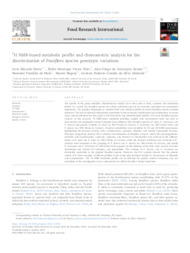1H NMR-based metabolic profile and chemometric analysis for the discrimination of Passiflora species genotypic variations.
1H NMR-based metabolic profile and chemometric analysis for the discrimination of Passiflora species genotypic variations.
Author(s): DUTRA, L. M.; TELES, P. H. V.; SANTOS, A. D. da C.; MELO, N. F. de; NAGATA, N.; ALMEIDA, J. R. G. da S.
Summary: The species of the genus Passiflora (Passifloraceae family) have been used as food, cosmetic and traditional herbal. As a result, the Passiflora species are widely cultivated and has an economic, medicinal and ornamental importance. The popular designation as ?passion fruit? and chemical profile of several Passiflora species remains unknown. The lack of chemical information contributes to the erroneous classification and adulteration. In recent years, special attention has been paid to the bioactivity and phytochemical profiles of several Passiflora species extracts. In this research, 1H NMR-based metabolic profiling coupled with chemometric tools was used to characterize and distinguish extracts obtained from different wild Passiflora species (P. alata, P. cincinnata, and P. setacea) and genetic varieties (P. alata var. BRS P ?erola do Cerrado, P. cincinnata var. BRS Sert ?ao Forte, and P. setacea var. BRS P ?erola do Cerrado). Fourteen metabolites were identified by 1D and 2D NMR experiments, highlighting the presence of fatty acids, carbohydrates, saponins, alkaloids, and mainly C-glycosidic flavones. Principal components analysis (PCA) allowed discrimination of Passiflora extracts, which the quadranguloside, oleanolic acid-3-sophoroside, ?-glucose, ?-glucose, and vitexin-2-O?-rhamnoside were relevant in the differen- tiation of P. alata and P. alata var. BRS P ?erola do Cerrado, while the flavones isovitexin and isovitexin-2-O?- xyloside were dominant in the grouping of P. setacea and P. setacea var. BRS P ?erola do Cerrado, and finally P. cincinnata and P. cincinnata var. BRS Sert ?ao Forte grouped by the influence of the fatty acids, sucrose, flavones (isoorientin and vitexin-2-O?-xyloside), and trigonelline. The varieties of P. setacea, and P. cincinnata are chemically equivalent to the original Passiflora species. However, the PCA analysis showed that the genetic variety of P. alata occupied a different position in the scores plot provoked mainly by the presence of oleanolic acid-3-sophoroside. The 1H NMR metabolic profile can be efficient for quality control evaluation, and can contribute to the investigation of new alternatives for official Passiflora herbal medicines.
Publication year: 2023
Types of publication: Journal article
Unit: Embrapa Semi-arid Region
Observation
Some of Embrapa's publications are published as ePub files. To read them, use or download one of the following free software options to your computer or mobile device. Android: Google Play Books; IOS: iBooks; Windows and Linux: Calibre.
Access other publications
Access the Agricultural Research Database (BDPA) to consult Embrapa's full library collection and records.
Visit Embrapa Bookstore to purchase books and other publications sold by Embrapa.

